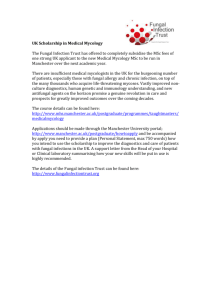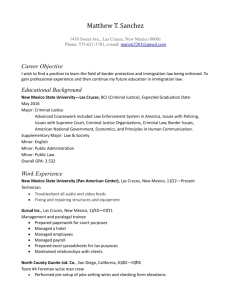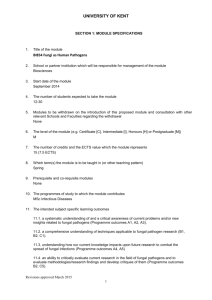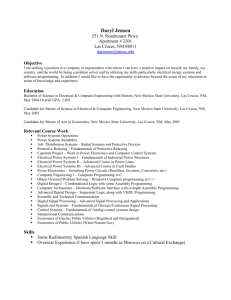Fungal Composition of Air and Precipitation in Southern New Mexico
advertisement
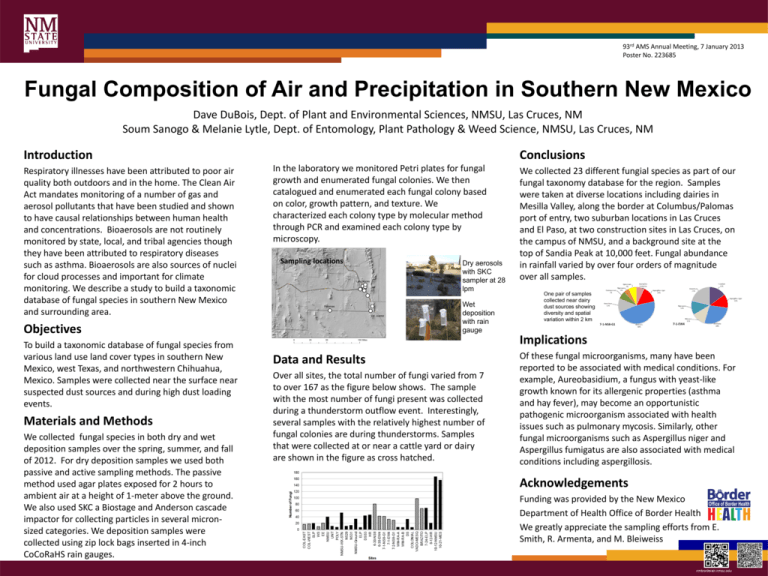
93rd AMS Annual Meeting, 7 January 2013 Poster No. 223685 Fungal Composition of Air and Precipitation in Southern New Mexico Dave DuBois, Dept. of Plant and Environmental Sciences, NMSU, Las Cruces, NM Soum Sanogo & Melanie Lytle, Dept. of Entomology, Plant Pathology & Weed Science, NMSU, Las Cruces, NM Introduction Respiratory illnesses have been attributed to poor air quality both outdoors and in the home. The Clean Air Act mandates monitoring of a number of gas and aerosol pollutants that have been studied and shown to have causal relationships between human health and concentrations. Bioaerosols are not routinely monitored by state, local, and tribal agencies though they have been attributed to respiratory diseases such as asthma. Bioaerosols are also sources of nuclei for cloud processes and important for climate monitoring. We describe a study to build a taxonomic database of fungal species in southern New Mexico and surrounding area. Conclusions In the laboratory we monitored Petri plates for fungal growth and enumerated fungal colonies. We then catalogued and enumerated each fungal colony based on color, growth pattern, and texture. We characterized each colony type by molecular method through PCR and examined each colony type by microscopy. Sampling locations Las Cruces Palomas Cd. Juarez Objectives To build a taxonomic database of fungal species from various land use land cover types in southern New Mexico, west Texas, and northwestern Chihuahua, Mexico. Samples were collected near the surface near suspected dust sources and during high dust loading events. Materials and Methods We collected fungal species in both dry and wet deposition samples over the spring, summer, and fall of 2012. For dry deposition samples we used both passive and active sampling methods. The passive method used agar plates exposed for 2 hours to ambient air at a height of 1-meter above the ground. We also used SKC a Biostage and Anderson cascade impactor for collecting particles in several micronsized categories. We deposition samples were collected using zip lock bags inserted in 4-inch CoCoRaHS rain gauges. Dry aerosols with SKC sampler at 28 lpm Wet deposition with rain gauge We collected 23 different fungial species as part of our fungal taxonomy database for the region. Samples were taken at diverse locations including dairies in Mesilla Valley, along the border at Columbus/Palomas port of entry, two suburban locations in Las Cruces and El Paso, at two construction sites in Las Cruces, on the campus of NMSU, and a background site at the top of Sandia Peak at 10,000 feet. Fungal abundance in rainfall varied by over four orders of magnitude over all samples. One pair of samples collected near dairy dust sources showing diversity and spatial variation within 2 km Implications Data and Results Over all sites, the total number of fungi varied from 7 to over 167 as the figure below shows. The sample with the most number of fungi present was collected during a thunderstorm outflow event. Interestingly, several samples with the relatively highest number of fungal colonies are during thunderstorms. Samples that were collected at or near a cattle yard or dairy are shown in the figure as cross hatched. Of these fungal microorganisms, many have been reported to be associated with medical conditions. For example, Aureobasidium, a fungus with yeast-like growth known for its allergenic properties (asthma and hay fever), may become an opportunistic pathogenic microorganism associated with health issues such as pulmonary mycosis. Similarly, other fungal microorganisms such as Aspergillus niger and Aspergillus fumigatus are also associated with medical conditions including aspergillosis. Acknowledgements Funding was provided by the New Mexico Department of Health Office of Border Health We greatly appreciate the sampling efforts from E. Smith, R. Armenta, and M. Bleiweiss nmborderair.nmsu.edu

